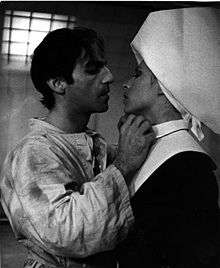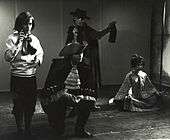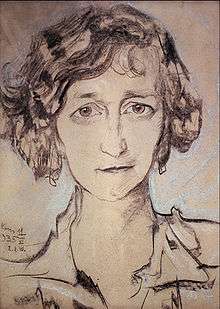Stanisław Ignacy Witkiewicz
| Stanisław Ignacy Witkiewicz | |
|---|---|
 | |
| Born |
24 February 1885 Warsaw, Poland |
| Died |
18 September 1939 (aged 54) Jeziory, Poland |
| Pen name | Witkacy |
| Occupation | Writer, painter, dramatist, philosopher |
| Nationality | Polish |
| Alma mater | Kraków Academy of Fine Arts |
| Notable works |
|
| Spouse | Jagwida Unrug, m.1923 |
| Partner | Jadwiga Janczewska |
| Relatives |
Father: Stanisław Witkiewicz Godmother: Helena Modjeska Father-in-law: Juliusz Kossak |
Stanisław Ignacy Witkiewicz (Polish: [staˈɲiswaf iɡˈnat͡sɨ vitˈkʲɛvit͡ʂ]; 24 February 1885 – 18 September 1939), commonly known as Witkacy, was a Polish writer, painter, philosopher, playwright, novelist, and photographer active in the interwar period.
Life
Born in Warsaw, Stanisław Ignacy Witkiewicz was a son of the painter, architect and an art critic Stanisław Witkiewicz. His mother was Maria Pietrzkiewicz Witkiewiczowa. Both of his parents were born in the Samogitian region of Lithuania. His godmother was the internationally famous actress Helena Modrzejewska.

Witkiewicz was reared at the family home in Zakopane. In accordance with his father's antipathy to the "servitude of the school," the boy was home-schooled and encouraged to develop his talents across a range of creative fields.
Witkiewicz was close friends with Karol Szymanowski and, from childhood, with Bronisław Malinowski and Zofia Romer. Following a crisis in Witkiewicz's personal life due to the suicide of his fiancée Jadwiga Janczewska, he was invited by Malinowski to act as draftsman and photographer on a 1914 expedition to Oceania, a venture that was interrupted by the onset of World War I. A happen-stance citizen of the Russian Empire, Witkiewicz went to St Petersburg and was commissioned as an officer in the Imperial army. His ailing father, a Polish patriot, was deeply grieved by the youngster's decision and died in 1915 without seeing his son again.
Witkiewicz witnessed the Russian Revolution while stationing in St Petersburg. He claimed that he worked out his philosophical principles during an artillery barrage, and that when the Revolution broke out he was elected political commissar of his regiment. His later works would show his fear of social revolution and foreign invasion, often couched in absurdist language.

He had begun to support himself through portrait painting and continued to do so on his return to Zakopane in Poland. He soon entered into a major creative phase, setting out his principles in New Forms in Painting and Introduction to the Theory of Pure Form in the Theatre. He associated with a group of "formist" artists in the early 1920s and wrote most of his plays during this period. Of about forty plays written by Witkiewicz between 1918 and 1925, twenty-one survive, and only Jan Maciej Karol Hellcat met with any public success during the author's lifetime. The original Polish manuscript of The Crazy Locomotive was also lost; the play, back-translated from two French versions, was not published until 1962.

After 1925, and taking the name 'Witkacy', the artist ironically re-branded his portrait painting which provided his economic sustenance as The S.I. Witkiewicz Portrait Painting Company, with the tongue in cheek motto: "The customer must always be satisfied". Several the so-called grades of portraits were offered, from the merely representational to the more expressionistic and the narcotics-assisted. Many of his paintings were annotated with mnemonics listing the drugs taken while painting a particular painting, even if this happened to be only a cup of coffee. He also varied the spelling of his name, signing himself Witkac, Witkatze, Witkacjusz, Vitkacius and Vitecasse — the last being French for "breaks quickly".
In the late 1920s he turned to the novel, writing two works, Farewell to Autumn and Insatiability. The latter major work encompasses geopolitics, psychoactive drugs, and philosophy. In 1935 he was awarded the Golden Laurel of the Polish Academy of Literature for his novels.[2]
During the 1930s, Witkiewicz published a text on his experiences of narcotics, including peyote, and pursued his interests in philosophy. He also promoted emerging writers such as Bruno Schulz. Shortly after Poland was invaded by Germany in September 1939, he escaped with his young lover Czesława to the rural frontier town of Jeziory, in what was then eastern Poland. After hearing the news of the Soviet invasion of Poland on 17 September 1939, Witkacy committed suicide on 18 September by taking a drug overdose and trying to slit his wrists.[3] He convinced Czesława to attempt suicide with him by consuming Luminal, but she survived.[4]
Witkiewicz had died in some obscurity but his reputation began to rise soon after the war, which had destroyed his life and devastated Poland. Czesław Miłosz framed his argument in The Captive Mind around a discussion of Witkiewicz's novel, Insatiability. The artist and theater director Tadeusz Kantor was inspired by the Cricot group, through which Witkiewicz had presented his final plays in Kraków. Kantor brought many of the plays back into currency, first in Poland and then internationally.
In the postwar period, Communist Poland's Ministry of Culture decided to exhume Witkiewicz's body, move it to Zakopane, and give it a solemn funeral. This was carried out according to plan, though no one was allowed to open the coffin that had been delivered by the Soviet authorities.
On 26 November 1994, the Polish Ministry of Culture and Art ordered the exhumation of the presumed grave of Witkiewicz in Zakopane. Genetic tests on the remaining bones proved that the body had belonged to an unknown woman — a final absurdist joke, fifty years after the publication of Witkacy's last novel.[5]
Art philosophy
- Nowe formy w malarstwie (1919), translated into English as New Forms in Painting and the Misunderstandings Arising Therefrom (in The Witkiewicz Reader, Quartet, 1993)
- Szkice estetyczne (Aesthetic Sketches, 1922)
Novels
- 622 Upadki Bunga czyli demoniczna kobieta (1911) partial translation into English as The 622 Downfalls of Bungo or The Demonic Woman (in The Witkiewicz Reader)
- Pożegnanie jesieni (1927) partial translation into English as Farewell to Autumn (in The Witkiewicz Reader)
- Nienasycenie (1930) translated into English as Insatiability (Quartet Encounter, 1985)
Plays


- Maciej Korbowa i Bellatrix (Maciej Korbowa and Bellatrix)(1918)
- Pragmatyści (1919) (translated into English as The Pragmatists)
- Mister Price, czyli Bzik tropikalny (1920) (translated into English as Mr Price, or Tropical Madness)
- Tumor Mózgowicz (1920) (translated into English as Tumor Brainiowicz)
- Nowe wyzwolenie (1920) (translated into English as The New Deliverance)
- Oni (1920) (translated into English as They)
- Panna Tutli-Putli (1920) (Miss Tootli-Pootli)
- W małym dworku (1921) (translated into English as Country House)
- Niepodległość trójkątów (1921) (translated into English as The Independence of Triangles)
- Metafizykja dwugłowego cielęcia (1921) (translated into English as Metaphysics of a Two-Headed Calf)
- Gyubal Wahazar, czyli Na przełęczach bezsensu (translated into English as Gyubal Wahazar, or Along the Cliffs of the Absurd: A Non-Euclidean Drama in Four Acts) (1921)
- Kurka Wodna (1921) (Translated into English as The Water Hen)
- Bezimienne dzieło (1921) (translated into English as The Anonymous Work: Four Acts of a Rather Nasty Nightmare)
- Mątwa (1922) (translated into English as The Cuttlefish, or The Hyrcanian World View)
- Nadobnisie i koczkodany, czyli Zielona pigułka (1922) (Translated into English as Dainty Shapes and Hairy Apes, or The Green Pill: A Comedy with Corpses)
- Jan Maciej Karol Wścieklica (1922) (translated into English as Jan Maciej Karol Hellcat)
- Wariat i zakonnica (1923) (translated into English as The Madman and the Nun)
- Szalona lokomotywa (1923) (translated into English as The Crazy Locomotive)
- Janulka, córka Fizdejki (1923) (translated into English as Janulka, Daughter of Fizdejko)
- Matka (1924) translated into English as The Mother (in The Mother & Other Unsavoury Plays, Applause, 1993)
- Sonata Belzebuba (1925) (translated into English as The Beelzebub Sonata)
- Szewcy (1931–34) translated into English as The Shoemakers (in The Mother & Other Unsavoury Plays, Applause, 1993)
Other works
- Narkotyki — niemyte dusze (1932), partial translation into English as Narcotics (in The Witkiewicz Reader)
- Pojęcia i twierdzenia implikowane przez pojęcie istnienia (Concepts and Statements Implied by the Idea of Existence) (1935)
- Jedyne wyjście
- Kompozycia fantastyczna
- Pocałunek mongolskiego księcia
Sample artwork
 Self-portrait
Self-portrait
1938.jpg) Self-portrait with Mrs. Maryla Grosmanowa
Self-portrait with Mrs. Maryla Grosmanowa
1927 Composition
Composition
1922 Nova Aurigae
Nova Aurigae
1918 Portrait of Zofia Romer by Witkacy (1935)
Portrait of Zofia Romer by Witkacy (1935) Portrait of Bronisława Wieniawa-Długoszowska by Witkacy (1918)
Portrait of Bronisława Wieniawa-Długoszowska by Witkacy (1918) Portrait of Jadwiga Janczewska, Zakopane (1913)
Portrait of Jadwiga Janczewska, Zakopane (1913)
Performances of work by Witkacy
- The Crazy Locomotive (Szalona lokomotywa) received its New York premier at the Chelsea Theatre in 1977, under the direction of Des McAnuff.[6] The Obie Award-winning production starred Dwight Schultz, Bob DeFrank and Glenn Close[7] in leading roles.[8]

- Two New York premiers of Witkacy plays: The Madman and the Nun (Wariat i zakonnica) in 1979 under the direction of Paul Berman and The Water Hen (Kurka Wodna) directed by Brad Mays were staged by the Theatre Off-Park,[9] in 1983.[10] Broadway producer / Theatre Off-Park managing director Patricia Flynn Peate[11] produced both plays, which were well received by critics and audiences alike. Future New York Times theatre critic Mark Matousek, then writing for the theatrical journal Other Stages, praised The Water Hen for "masterful comic direction,"[12] and the piece was videotaped for permanent inclusion in the Lincoln Center's Billy Rose Theatre Collection.
- The New York premiere of The Shoemakers (Szewcy) was presented by the Jean Cocteau Repertory under the direction of Włodzimierz Herman in 1987.[13]
- The Madman and the Nun was presented in 1989 by The Cosmic Bicycle Theatre at the Summer Music from Greensborough, a Classical Music Festival in Greensborough, Vermont, and in Boston, at The Charlestown Working Theatre. Directed by Jonathan Edward Cross [a.k.a. Jonny ClockWorks]. The production used Actors alongside Life-sized Puppets. Two of the original Puppet Figures are in the collection of the Witkacy Teatre in Zarkopane' Poland.[14]
- The New York premiere of Witkacy's Tumor Brainiowicz presented by La MaMa ETC was performed by The Theatre of a Two-Headed Calf (named after the Witkacy play Metaphysics of a Two-Headed Calf), under the direction of Brooke O'Harra. This production was followed by Witkacy's The Mother in 2003, also under O'Harra's direction and also a New York premier. The production featured puppets and video.[15]
See also
References
- ↑ Frantczak, Ewa; Okołowicz, Stefan (1986). Przeciw nicości : fotografie Stanisława Ignacego Witkiewicza. Kraków: Wydawnictwo Literackie. p. 63. ISBN 83-08-01398-8.
- ↑ Prof. dr hab. Miłosława Bulowska Schielman. "Stanisław Ignacy Witkiewicz". Virtual Library of Polish Literature. Retrieved 13 December 2011.
- ↑ Donald Pirie; John Bates; Elwira Grossman. "Stanislaw Ignacy Witkiewicz". Retrieved 16 April 2009.
- ↑ Journal of Czesława Oknińska, quoted in: Gerould, Daniel Charles; Witkiewicz, Stanisław Ignacy (1992). "Part 5: Philosophy and Suicide, 1931–1939". The Witkiewicz Reader. Northwestern University Press. p. 275. ISBN 978-0-8101-0994-0. Retrieved 22 November 2009.
- ↑ "...Przeprowadzone badania wykazują, że szczątki kostne, przywiezione w 1988 roku ze wsi Jeziory na Ukrainie należą do kobiety w wieku 25–30 lat, o wzroście około 164 cm. ..." ("the tests conducted indicate that the bone remains, brought in 1988 from the village Jeziory in the Ukraine, belong to a woman 25–30 years old and about 164 cm tall...") from the protocol of the commission called by the Ministry of Culture and Art after the exhumation on 26 November 1994 of the presumed grave of Stanisław Ignacy Witkiewicz at Pęksowy Brzyzek" cemetery in Zakopane. From: Maciej Pinkwart, "Wygraliśmy" at the Wayback Machine (archived 20 January 2010) in: "Moje Zakopane" dn. 21 February 2005. (Source: Komunikat Komisji powołanej przez Ministra Kultury i Sztuki do spraw pochówku Stanisława Ignacego Witkiewicza. Prof. dr hab. Tadeusz Polak). Retrieved 11 November 2012.
- ↑ http://broadwayworld.com/shows/cast.php?showid=327362 BroadwayWorld: The Crazy Locomotive, complete cast & crew listing.
- ↑ http://www.lortel.org/LLA_archive/index.cfm?id=2960&search_by=show
- ↑ http://www.signonsandiego.com/uniontrib/20070408/news_lz1a08des.html
- ↑ Cantwell, Mary (6 January 1996). "Editorial Notebook;Small Theater". The New York Times. Retrieved 24 May 2010.
- ↑ Mark Matusek, NY Times, The Water Hen, NYC Production - 1983. BradMays.com. Retrieved 21 July 2015.
- ↑ "No Headline". The New York Times. 31 October 1983. Retrieved 24 May 2010.
- ↑ Matousek, Mark (1983). "Water Hen – (review)". Other Stages.
- ↑ "The Shoemakers by Stanislaw I. Witkiewicz, Poland's greatest modern playwright; first English-language performance by the Jean Cocteau Repertory". The New York Times.
- ↑ http://southbrooklynpost.com/things-to-do/puppet-theatre-party/
- ↑ http://www.lamama.org/archives/2003/THEMOTHER.htm
- Sarah Boxer, "A Polish Satirist Obsessed with Identity". New York Times, 24 April 1998
- F. Coniglione, Polish Philosophy Page: Stanisław Ignacy Witkiewicz at the Wayback Machine (archived 9 February 2008)
- Halina Florynska-Lalewicz, Monika Mokrzycka-Pokora, Irena Kossowska, Stanisław Ignacy Witkiewicz (Witkacy) at culture.pl
- Daniel Gerould, Witkacy: Stanisław Ignacy Witkiewicz as an Imaginative Writer (University of Washington Press, 1981)
- Stanislaw Ignacy Witkiewicz Bibliography, including Bio
- Łozińska Hempel, Maria (1986). Z łańcucha wspomnień. Wydawnictwo Literackie.
External links
| Wikimedia Commons has media related to Stanisław Ignacy Witkiewicz. |
- Works by Stanisław Ignacy Witkiewicz at Open Library

- Stanisław Ignacy Witkiewicz (Witkacy) at Culture.pl
- Witkiewicz & Futurism – The Crazy Locomotive